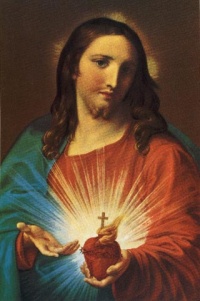Sacred Heart
From The Art and Popular Culture Encyclopedia
| Revision as of 19:57, 7 January 2014 Jahsonic (Talk | contribs) ← Previous diff |
Current revision Jahsonic (Talk | contribs) |
||
| Line 1: | Line 1: | ||
| + | [[Image:Sacred Heart by Pompeo Batoni.jpg|thumb|left|200px|''[[Il Sacro Cuore]]'', [[Church of the Gesù]], [[Rome]] by [[Pompeo Batoni]]]] | ||
| {{Template}} | {{Template}} | ||
| - | The '''Sacred Heart''' (also known as '''Most Sacred Heart of Jesus''') is one of the most famous religious [[Catholic devotions|devotions]] to [[Jesus]]' physical [[Human heart|heart]] as the representation of His divine love for Humanity. The Sacred Heart is often depicted in [[Christian art]] as a flaming heart shining with divine light, pierced by the lance-wound, surrounded by the [[crown of thorns]], surmounted by a cross and [[bleeding]]. Sometimes the image shown shining within the bosom of Christ with his wounded hands pointing at the heart. The wounds and crown of thorns allude to the manner of [[Passion (Christianity)|Jesus' death]], while the fire represents the transformative power of divine love. | + | The '''Sacred Heart''' (also known as '''Most Sacred Heart of Jesus''') is one of the most famous religious [[Catholic devotions|devotions]] to [[Jesus]]' physical [[Human heart|heart]] as the representation of His [[divine love]] for Humanity. The Sacred Heart is often depicted in [[Christian art]] as a flaming heart shining with [[divine light]], pierced by the [[Holy Lance|lance-wound]], surrounded by the [[crown of thorns]], surmounted by a [[Christian cross|cross]] and [[bleeding]]. Sometimes the image shown shining within the bosom of Christ with his wounded hands pointing at the heart. The wounds and crown of thorns allude to the manner of [[Passion (Christianity)|Jesus' death]], while the fire represents the transformative power of divine love. |
| + | ==Origion== | ||
| + | The origin of this devotion in its modern form is derived from a Roman Catholic [[nun]] from [[France]], [[Margaret Mary Alacoque]], who said she learned the devotion from Jesus during a series of [[Visions of Jesus and Mary|apparitions]] which occurred between 1673 and 1675. | ||
| + | In June 1674, she described one of her visions: | ||
| + | :“The Divine Heart was presented to me in a throne of flames, more brilliant than a sun, transparent as crystal, with this adorable wound. And it was surrounded with a crown of thorns, signifying the punctures made in it by our sins, and a cross above signifying that from the first instant of His Incarnation, […] the cross was implanted into it […].” | ||
| + | |||
| + | ==Depictions== | ||
| + | *''[[Il Sacro Cuore]]'', painting, [[Pompeo Batoni]], 1740, | ||
| + | *[[Frontispiece to De Culto Sacro Sancti Cordis Dei]] | ||
| ==See also== | ==See also== | ||
| - | * [[Annum Sacrum]] | + | *[[Depictions of Jesus]] |
| - | * [[Act of Consecration to the Sacred Heart of Jesus]] | + | *[[Five Holy Wounds]] |
| * [[Catholic devotions]] | * [[Catholic devotions]] | ||
| - | * [[Immaculate Heart of Mary]] | + | * [[Sacré-Cœur, Paris]] |
| - | * [[Alliance of the Hearts of Jesus and Mary]] | + | |
| - | * [[Sacred Heart Cathedral]] | + | |
| - | * [[Cathedral of the Sacred Heart]] | + | |
| * [[Tattoo]] | * [[Tattoo]] | ||
| * [["Execution" of the Sacred Heart by leftist militiamen at Cerro de los Ángeles near Madrid, on 7 August 1936 ]] | * [["Execution" of the Sacred Heart by leftist militiamen at Cerro de los Ángeles near Madrid, on 7 August 1936 ]] | ||
| {{GFDL}} | {{GFDL}} | ||
Current revision
|
Related e |
|
Featured: |
The Sacred Heart (also known as Most Sacred Heart of Jesus) is one of the most famous religious devotions to Jesus' physical heart as the representation of His divine love for Humanity. The Sacred Heart is often depicted in Christian art as a flaming heart shining with divine light, pierced by the lance-wound, surrounded by the crown of thorns, surmounted by a cross and bleeding. Sometimes the image shown shining within the bosom of Christ with his wounded hands pointing at the heart. The wounds and crown of thorns allude to the manner of Jesus' death, while the fire represents the transformative power of divine love.
Origion
The origin of this devotion in its modern form is derived from a Roman Catholic nun from France, Margaret Mary Alacoque, who said she learned the devotion from Jesus during a series of apparitions which occurred between 1673 and 1675.
In June 1674, she described one of her visions:
- “The Divine Heart was presented to me in a throne of flames, more brilliant than a sun, transparent as crystal, with this adorable wound. And it was surrounded with a crown of thorns, signifying the punctures made in it by our sins, and a cross above signifying that from the first instant of His Incarnation, […] the cross was implanted into it […].”
Depictions
- Il Sacro Cuore, painting, Pompeo Batoni, 1740,
- Frontispiece to De Culto Sacro Sancti Cordis Dei
See also
- Depictions of Jesus
- Five Holy Wounds
- Catholic devotions
- Sacré-Cœur, Paris
- Tattoo
- "Execution" of the Sacred Heart by leftist militiamen at Cerro de los Ángeles near Madrid, on 7 August 1936


